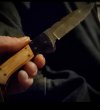- Joined
- Jul 24, 2022
- Messages
- 89
I'm sure everyone has seen it. Window shopping for knives on ebay or other such reputable sites. "Custom Damascus knife hand made $40" obviously its just an acid etched pattern but how can Damascus be measured and defined in a way that can be repeated and reliable.
I know the technical definitions of Damascus. The real Damascus steel from antiquity that somehow cannot be duplicated. Supposedly this is the type of steel that pierced the side of christ. So how do you make a steel that can kill a God? Fold two steels together until they are welded? Which two steels? How many times? Until Damascus has been given a true definition I think I will just keep my distance. And not Damasteel, don't start me on that.
If you have any knives thst were sold under the label of Damascus steel post em here. I'll start with this Perkins Damascus type steel knife. It is supposedly actually two different steels folded together and the pattern does appear on the edge but I'm not gonna go sanding it and putting iron ferrite on it.

Edit: The more I am researching the more strongly I believe no knife should bare the Label Damascus unless it meets the qualifications of original Damascus steel from 700AD. Which means no, it did not kill our savior. It should rather be called pattern welded steel or pattern etched.
The original composition is very interesting. It contained a steel formed in India under the label Wootz steel. Wootz steel was crucible formed with trace impurities like vanadium, molybdenum and carbon nanotubes and I believe this is where we have issues with duplication. Carbon nanotube technology hasn't caught up to a point where we can properly reverse engineer Wootz steel. This steel then made its way to Syria where it was folded with a carbon steel containing nickel alloys. They didn't have sheet steel back then so they would forge wires which were put on a mandrill and hammered into a form. Then reforged into their final shape.
Interesting stuff especially when you consider it would be pretty difficult to make this by accident let alone then duplicate it. Im thinking aliens man.
I know the technical definitions of Damascus. The real Damascus steel from antiquity that somehow cannot be duplicated. Supposedly this is the type of steel that pierced the side of christ. So how do you make a steel that can kill a God? Fold two steels together until they are welded? Which two steels? How many times? Until Damascus has been given a true definition I think I will just keep my distance. And not Damasteel, don't start me on that.
If you have any knives thst were sold under the label of Damascus steel post em here. I'll start with this Perkins Damascus type steel knife. It is supposedly actually two different steels folded together and the pattern does appear on the edge but I'm not gonna go sanding it and putting iron ferrite on it.

Edit: The more I am researching the more strongly I believe no knife should bare the Label Damascus unless it meets the qualifications of original Damascus steel from 700AD. Which means no, it did not kill our savior. It should rather be called pattern welded steel or pattern etched.
The original composition is very interesting. It contained a steel formed in India under the label Wootz steel. Wootz steel was crucible formed with trace impurities like vanadium, molybdenum and carbon nanotubes and I believe this is where we have issues with duplication. Carbon nanotube technology hasn't caught up to a point where we can properly reverse engineer Wootz steel. This steel then made its way to Syria where it was folded with a carbon steel containing nickel alloys. They didn't have sheet steel back then so they would forge wires which were put on a mandrill and hammered into a form. Then reforged into their final shape.
Interesting stuff especially when you consider it would be pretty difficult to make this by accident let alone then duplicate it. Im thinking aliens man.
Last edited:




